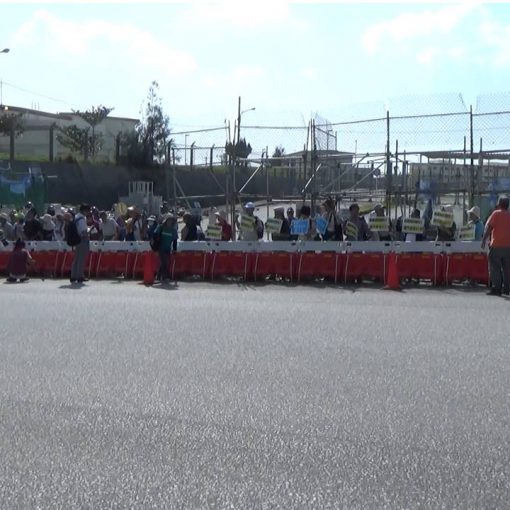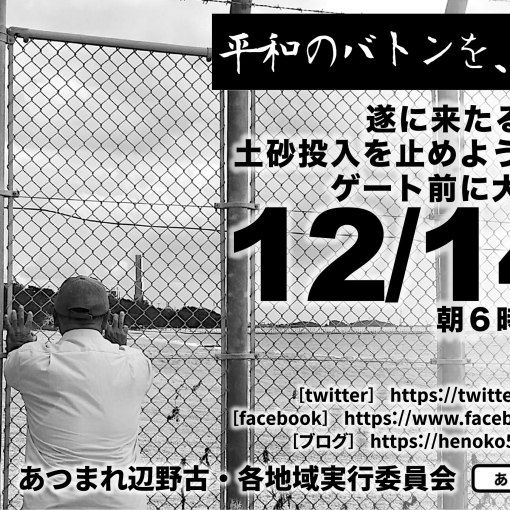On Sep 21, the sit-in rally at the beach tent marked 6000th day. The rally started on Apr 19, 2004, when the boring seafloor survey at the offshore Henoko began. At that time, only a few people from outside Okinawa supported the protest. The support came mainly from the residents of Henoko, who demanded the Okinawa Defense Bureau to stop the construction.
As support from mainland Japan increased, the donation had amounted enough to purchase a few boats and canoes. When a survey scaffold was built, the protestors clung to it in the cold weather and stopped the survey. Okinawan grandpas and grandmas who lived through ground battle of WW II gathered every day to sit-in with firm conviction not to build another war tool, a military base. Excepting the bad weather, they have been out on the sea to protest every day. Ms.Etsuko Urashima, one of the initial protest members, shared her thoughts regarding members of the Japan Coast Guard and the construction workers. “We used to talk to the surveyors in 2004, but not now. Since 2014 when the operation resumed, the central government ensured that the workers did not contact the protestors. However, I am certain that the construction workers and Japan Coast Guard members do not want to see the battle of Okinawa repeated.” The protestors have organized a special meeting at every turning point, but to prevent the COVID-19 contagion, they decided not to have one this year.

(In front of the Camp Schwab Gate)
Nearly 20 people resumed the sit-in rally from 8:40 a.m. They discussed how careless the request for a design change submitted by the Okinawa Defense Bureau was. Learning that the Okinawa Defense Bureau would call in 100 vessels to the Oura Bay to improve the soft ground, they criticized, “The Bay is already crowded. it is impossible. “Upon receiving the news that over 4000 opinion statements have reached the prefectural government office as of Sep 23, the protestors pledged to urge more people to send in their opinion statements so that a total will go over 10,000.
A total of 175 trucks, including some concrete mixers, delivered the construction materials.
(Ryukyu Cement Awa Pier)
Approximately 30 people, including the Peace Citizens’ Liaison Committee (Okinawa Heiwa Shimin Rennrakukai) members, divided themselves to the pier’s entrance and exit to protest against the dump trucks. The temporary storage area became full, and the delivery operation finished one hour earlier than usual at 6:30 p.m. Eight canoe members tied their canoes to the nets under the pier on the sea, trying to prevent the cargo vessels from leaving the pier. They successfully delayed the departure for about one hour before the Japan Coast Guard removed the canoes.
A total of 652 truckloads of the earth and sand was loaded to two cargo ships, which left for the Oura Bay.



(Motobu Shiokawa Pier)
Loading by using a sand carrier with a grab bucket took place. To comply with the contract, they must use a sand carrier with a grab bucket once a month. It was so inefficient that the trucks were often tied up in the waiting queue to unload their loads, although only 16 trucks were in operation for the day.
A total of 132 truckloads, only 1/3 of the average day-load, were loaded to the cargo ships.

Number of dump trucks to date and percentage against the total
The estimation calculated on the basis of the number of ruckloads serves only as a reference.
Number of dump trucks which made delivery from December 2018 to the end of December 2019 114,601(1.39%)
| 19(Sat) | 21(Mon) | 22(Tue) | 23(Wed) | 24(Thr) | 25(Fri) | |
| Awa | 828 | 0 | 0 | 466 | 495 | 652 |
| Shiokawa | 0 | 0 | 0 | 522 | 525 | 132 |
| Number of dump trucks ※ |
Weightt of earth/sand
※① |
Converted to volume
※② |
Volume per Total
※③ |
| 247,654 | 1,238,270t | 619,135㎥ | 3.065% |
※ Cumulative since Dec. 1, 2019
※① Calculated by assuming that the average truckload per dump truck would be 5 tons
※② Calculated by assuming that a specific weight of soil/sand set to be 2
※③ Percentage against 20.200.000m3, the total volume of earth and sand required for the landfill.




